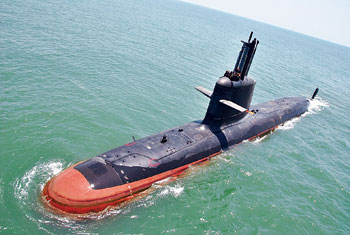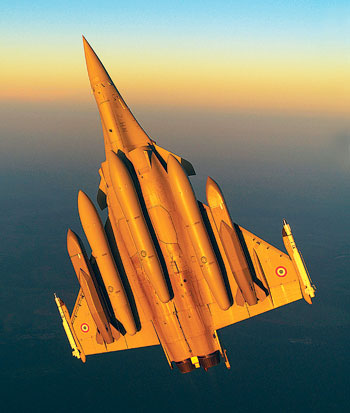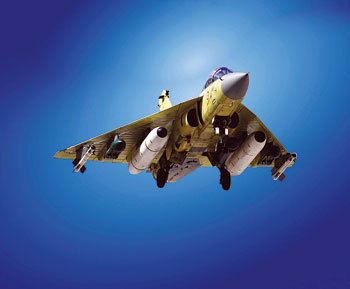INDIAN ARMED FORCES CHIEFS ON
OUR RELENTLESS AND FOCUSED PUBLISHING EFFORTS

SP Guide Publications puts forth a well compiled articulation of issues, pursuits and accomplishments of the Indian Army, over the years

I am confident that SP Guide Publications would continue to inform, inspire and influence.

My compliments to SP Guide Publications for informative and credible reportage on contemporary aerospace issues over the past six decades.
- Prime Minister witnesses 'Bharat Shakti' – a Tri-Services Firing and Manoeuvre Exercise in Pokhran, Rajasthan
- Interim Defence Budget 2024-25 — An Analysis
- Union Defence budget 2024
- Prime Minister Modi Commemorates Indian Navy Day in a Grand Ceremony
- Prime Minister Modi Flies in the LCA Tejas
- New Chapter in India-Italy Defence Ties
- Airpower beyond Boundaries
2016: An eventful year for Ministry of Defence



Speedy modernisation of the armed forces to meet present and emerging challenges, development of requisite capacities and infrastructure for making up critical deficiency of weapons and equipment and creating a robust defence set up in the country through the ‘Make in India’ initiative, were the salient achievements of the Ministry of Defence (MoD) during 2016.
The year also saw progress for the welfare of ex-servicemen as the much awaited One Rank, One Pension (OROP) scheme funds reaching the accounts of ex-servicemen and families. During the year as part of defence diplomacy, India engaged with its neighbours and Far Eastern countries, as well also developed countries through bilateral talks, ship visits and trilateral military exercises. To expedite capacity building, as well as offensive capabilities of the armed forces, the Defence Acquisition Council (DAC), the apex body of the Ministry of Defence in matters of acquisitions, cleared different critical and high-end defence procurement proposals to the tune of more than Rs. 1,00,000 crore.
The new Defence Procurement Procedure (DPP) 2016 was promulgated for capital procurements and came into effect from April 1, 2016. DPP 2016 has a focus on achieving the ‘Make in India’ vision by according priority to ‘Buy Indian–IDDM’ (Indian Designed, Developed and Manufactured) and ‘Buy (Indian)’ categories. It also focuses on enhancement and rationalisation of indigenous content.
The Ministry of Defence also issued guidelines for penalties in business dealings with entities, which have come into effect from November 21. The guidelines lay down policy for levy of financial penalties and/or suspension/banning of business dealings with entities, seeking to enter into contract with/having entered into a contract for the procurement of goods and services by the Ministry of Defence. ‘Entities’ will include companies, trusts, societies, as well as individuals and their associations with whom the Ministry of Defence has entered into, or intends to enter into, or could enter into contracts or agreements. The guidelines are available at http://mod.nic.in/writereaddata/guideentities.pdf.
Indian Army
Current Situation in Jammu and Kashmir: The security situation in J&K is at an important crossroads. Ceasefire violations (CFVs) which saw a significant rise in the preceding months, wherein several incidents of calibre escalation to artillery/120mm mortar were attempted by Pakistan. This has seen a drastic reduction in CFVs post the Director General of Military Operations (DGMO) level talks which took place on November 23. Relentless operations by the Army both along the line of control (LoC) and in the hinterland in concert with other security forces have thwarted the designs of the nexus to give a fillip to the proxy war being waged against India. Army along with Central Armed Police Forces (CAPF) and J&K Police continues to put in relentless efforts to bring back normalcy to the Kashmir Valley.
Situation along LAC: There is no commonly delineated line of actual control (LAC) in the border areas between India and China. From time to time, on account of differing perception of the LAC, situations have arisen on the ground that could have been avoided if we had a common perception of the LAC. Army regularly takes up any such situation along the LAC with the Chinese side through established mechanism including border personnel meetings, flag meetings, meeting of Working Mechanism for Consultation & Coordination on India-China Border Affairs and diplomatic channels.
Surgical Strikes along LoC: Based on specific and credible inputs about some terrorist teams having positioned themselves at launch pads along LoC to carry out infiltration and conduct terrorist strikes in Jammu and Kashmir and in various metros in other states, the Indian Army conducted surgical strikes on September 29 at several of these launch pads to pre-empt infiltration by terrorists.
The operations were focused on ensuring that these terrorists did not succeed in their design to cause destruction and endanger the lives of our citizens. During these counter terrorist operations significant casualties were caused to terrorists and those providing support to them.
Training Events and Military Exercises: The following exercises were conducted with different countries: India-France Joint Military Exercise Shakti; India-Nepal Combined Military Training Exercise Surya Kiran IX; India–Indonesia Joint Training Exercise Garuda Shakti IV; Exercise Force-18, the largest ground forces multinational field training exercise on Humanitarian Mine Action and Peacekeeping Operations culminated at Pune; Exercise Shatrujeet; Exercise Chakravyuh-II; Exercise Jalrahat; Exercise Maitree; Exercise Yudh Abhyas; India-Kazakhstan Joint Exercise; Exercise Indra-2016 with Russia; Sino-Indian Joint Exercise, and India-China Joint Training Exercise.
Indian Navy
To enhance its blue water capability, the Indian Navy opted to strengthen its submarine arm for which request for proposal (RFP) to acquire six more conventional submarines under Project 75(I) was cleared by the DAC. The project will cost around Rs. 80,000 crore.
Kalvari, the first of the Scorpene class submarine, being built at the Mazagon Dock Shipbuilders Limited in Mumbai (MDL), went to sea on May 1 under her own propulsion for the first sea trial, off the Mumbai coast. The submarine is presently undergoing advanced/deep-dive trials and is likely to be commissioned in early 2017.
Bilateral/multilateral Exercises: To enhance India’s presence in the maritime arena/across area of responsibility/interest, the Indian Navy was deployed extensively across the globe and conducted exercises with friendly foreign navies. Some of these are: Naseem-Al-Bahr with the Royal Navy of Oman; the International Fleet Review (IFR) 2016 at Visakhapatnam from February 4-8, culminated with Indian and foreign naval ships undertaking a Passage Exercise (PASSEX) in the Bay of Bengal on February 9. Some 54 ships that participated in IFR 2016 sailed out from Visakhapatnam in the first ever PASSEX with combined participation of foreign and Indian warships. The unprecedented scale and scope of the PASSEX was indicative of India’s growing stature in the maritime domain and the bridges that have been painstakingly built by the Indian Navy towards achieving the motto of the International Fleet Review in letter and spirit ‘United through Oceans’.
Then there were Exercise Malabar 2016 with US and Japan; Exercise RIMPAC off Hawaii; Indo-Thai Coordinated Patrol (CORPAT); ADMM Plus Exercise on Maritime Security and Counter Terrorism; Coordinated Patrol and India-Indonesia Bilateral Maritime Exercise; Exercise Konkan 16; Indra Navy 2016; Indo-Myanmar Coordinated Patrol (IMCOR); deployment of P-8(I) to Seychelles for EEZ Surveillance; INS Beas visits Doha; deployment to Male, Maldives: Western Fleet ships INS Vikramaditya and deployment to Mauritius: and Ships of First Training Squadron visited Thailand and Sri Lanka.
Commission of Trials of Ships: INS Kadmatt, second ship of Project 28 (P-28) class anti-submarine warfare corvettes, indigenously designed by the Indian Navy’s in-house organisation, the Directorate of Naval Design and constructed by the Garden Reach Shipbuilders and Engineers Limited (GRSE), Kolkata, was commissioned at the Naval Dockyard in Visakhapatnam on January 7.
Launch of Yard 2097/2098/2099: The sixth, seventh and eighth ships of LCU MK IV project were launched in March, November and December at the GRSE.
INS Tarmugli: The Indian Navy commissioned the highly manoeuvrable fast attack craft INS Tarmugli at a ceremony at the Naval Dockyard in Visakhapatnam on May 23.
Indian Air Force
Rafale Acquisition Deal: The much awaited Rafale deal with France was signed on September 23 in New Delhi under which France will provide 36 Rafale fighter jets to India. The twinengine, multi-role aircraft will be capable of carrying out various combat missions like air defence, ground attack, reconnaissance, anti-ship strikes, etc.
Tejas Induction: The light combat aircraft (LCA) Tejas was inducted into No. 45 Squadron of the Indian Air Force (IAF) on July 1. The squadron will operate from Bengaluru for nearly two years, before it moves to its designated location at Sulur near Coimbatore. It is the first fighter squadron to be a part of the Southern Air Command of IAF headquartered at Thiruvananthapuram.
Operations
The IAF had embarked on an ambitious reconstruction plan to upgrade eight ALGs including infrastructure development at an overall outlay of nearly Rs. 1,000 crore following a MoU between the Government of Arunachal Pradesh and the Ministry of Defence in June 2009. Five ALGs at Ziro, Along, Mechuka, Pasighat and Tuting were upgraded and made operational in 2016.
Exercises
Exercise Iron Fist 2016: A day-night exercise demonstrating the combat and firepower of the IAF was conducted on 18 Marat Rajasthan’s Pokhran firing range in the presence of the President Pranab Mukherjee and Prime Minister Narendra Modi. The event comprised of six packages depicting six themes in which more than 180 aircraft, including fighters, transport and helicopters participated.
HADR Operations
Op Sankat Mochan: Stranded Indian nationals were evacuated from Juba, the capital of war-torn South Sudan on July 14. The Minister of State for External Affairs, General V.K. Singh (Retd), flew to Juba in one of the two C-17 Globemaster aircraft in the operation which was named Operation Sankat Mochan.
Defence Cooperation
Exercise Red Flag with US Air Force; Desert Eagle II with UAE: This was the second in the series of bilateral exercises between the IAF and the United Arab Emirates Air Force (UAEAF). This was a 10-day air combat exercise in which the IAF and the UAEAF undertook air exercises from Al-Dhafra Air Base, Abu Dhabi starting from May 22.
India gets Women Fighter Pilots: History was created as the first three women fighter pilots of the IAF were commissioned at the Combined Graduation Parade at Air Force Academy, Dundigal, on June 18. With this, India joined a select few nations in the world that have women fighter pilots. These women fighter pilots are Flying Officers Avani Chaturvedi, Bhawana Kanth and Mohana Singh. Subsequently, on August 12 Marshal of the Indian Air Force Arjan Singh, DFC, felicitated the three women fighter pilots in New Delhi.
Defence Research and Development Organisation
Agni-V Successfully Test-fired: Agni-V, the long-range surface-tosurface ballistic missile, was successfully flight tested by DRDO on December 26 from Dr Abdul Kalam Island, Odisha. The full range test-flight of the missile further boosted the indigenous missile capabilities and deterrence level of the country.
Light Combat Aircraft (LCA) Tejas: Indigenously developed LCA is an advanced technology, single-seat, single-engine, supersonic, lightweight, all-weather, multi-role, air superiority fighter designed for air-to-air, air-to-ground and air-to-sea combat roles. During the year, Tejas made its international debut in January 2016 with participation in the Bahrain International Air Show. The Hindustan Aeronautics Limited (HAL) handed over the first two Tejas aircraft to IAF at a ceremony at the Aircraft and Systems Testing Establishment (ASTE) in Bengaluru on July 1, 2016, which will make up the Flying Daggers 45, the name of the first squadron of LCA.
Long-range Surface-to-Air Missile (LRSAM): LRSAM is a joint development programme of DRDO, Indian Navy and Israel Aerospace Industries (IAI). The missiles are intended to equip three guided missile destroyers of the Indian Navy. LRSAM home-on-tests were conducted at the Integrated Test Range (ITR) during September to prove three intercept scenarios with Banshee Jet 80 as target.
Medium-range Surface-to-Air Msissile (MRSAM): MRSAM is being developed for the IAF for protecting our territory and ground forces from air attacks by intercepting aerial targets like fighter aircraft and guided weapons. The system is jointly developed by DRDO, IAF and IAI, Israel. During the year, three flight trials were successfully carried out in June and July to evaluate target detection and tracking by Long Range Detection and Tracking Radar, missile launch and homing on target and radar tracking.
Anti-tank Missile PROSPINA: Nag is a third-generation antitank missile (ATM) with fire & forget and top attack capabilities, which can be used in day and night. It is deployed on a specially modified infantry combat vehicle (ICV) BMP-2 vehicle NAMICA. During the year, guided flight tests of Nag were carried out with the objective of demonstrating range capabilities of IIR Seeker during worst time of the day in summer environment.





